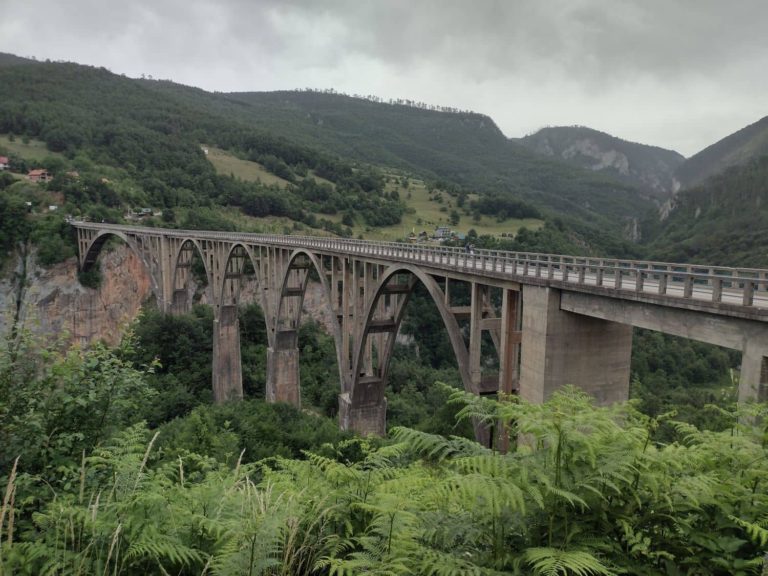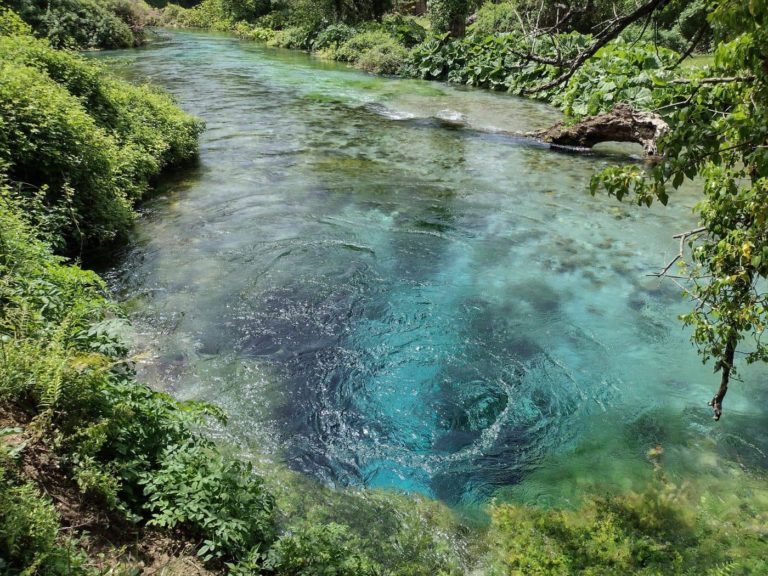Palomino is a slow-going village with uneven dirt roads and brightly colored street art. Its energy is entrancing, its nature wild and unkept, and the people perfectly content staying past their original travel plans.
My time spent here reminded me of my early days wandering aimlessly through Thailand and Laos. It still feels untouched by the outside world, like those long-forgotten backpacker beach towns that are harder to come by with every passing year.
The town reflects much of that, with its lack of ATMs and an identity that heavily relies on tropical nature and relaxation. I grew to embrace this feeling once again, and in the end, thoroughly enjoyed my time in Colombia’s sleepy coastal village.
I came here on two separate occasions, once to simply do nothing but bask on the beach, and the other to explore the nearby towns and wilderness. This is my guide to Palomino, with advice on where to stay and some of my favorite food spots. I also share some tips on transport and day trips to an epic waterfall and the nearby Tayrona National Park.
Here are some of my top things to do in Palomino, Colombia.
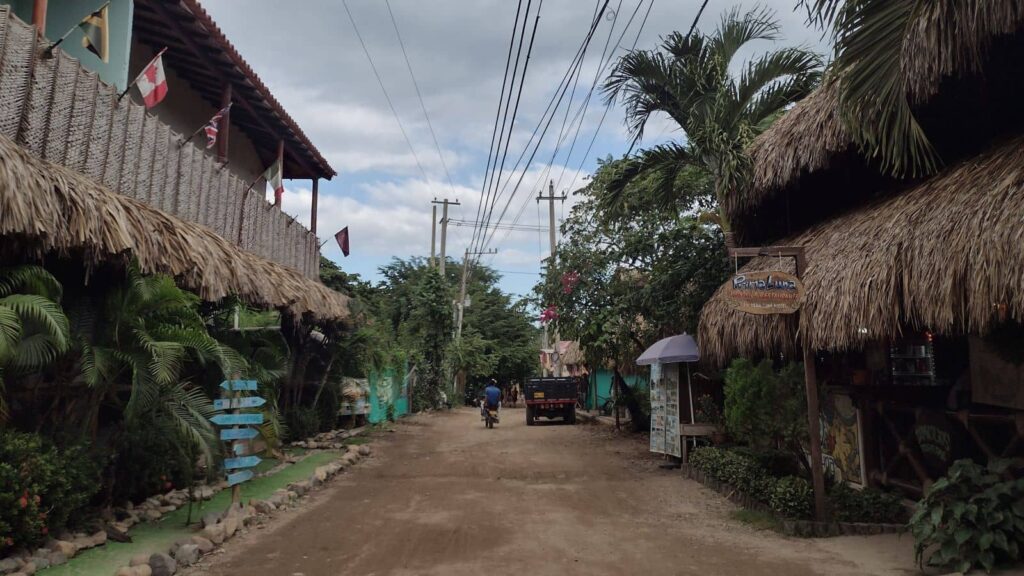
Embrace Beach Life In Palomino
The main attraction of Palomino is, of course, the untamed beach known as Playa Palomino. That’s how the village gained its popularity, and for the most part, that’s why people stick around for so long.
Lounging around at beaches is one of my preferences when choosing a travel destination and it’s hard to think of a better place to do it than here. Unfortunately, the water isn’t very swimmable, with wild currents and brutish waves for those without a surfboard.
However, it makes up for it with its natural beauty and nonchalant atmosphere. Plus, you’ll be able to keep busy at almost any hour here.
MORNINGS AT THE BEACH
Early mornings were some of my favorite times on Playa Palomino. With the unwavering heat of the high sun, I often saw myself rising at the crack of dawn in northern Colombia. Luckily for me, the sunrise walk from the beach entrance near The Dreamer Hostel to Rio Palomino was a stunning one.
It’s not for everyone, but if you manage to wake early, or stay up until morning for that matter, I suggest walking towards the river to get breathtaking views of the snowcapped Pico Cristóbal Colón. It’s a peaceful time, with cooling winds emanating from the sea and the crash of waves making a melodic sound.
Afterward, grab a coffee from a nearby cafe or bakery and grab a spot on the sand for the rest of the day.

DAYS AT THE BEACH
Days at Playa Palomino consist of sunbathing, relaxation, and general slow-paced living. Juice shacks pop up on different parts of the sandy shores and there are plenty of shaded spots to find under rows of uncultivated palm trees.
If you’re up for the challenge, you can rent a surfboard to hit the waves. Despite the less-than-ideal swimming conditions, surfing is still in the cards and one of the best things to do in Palomino.
Some hostels, as well as a few surf schools along the beach offer boards for hire. You can either rent on an hourly basis or join private or group lessons for the day.

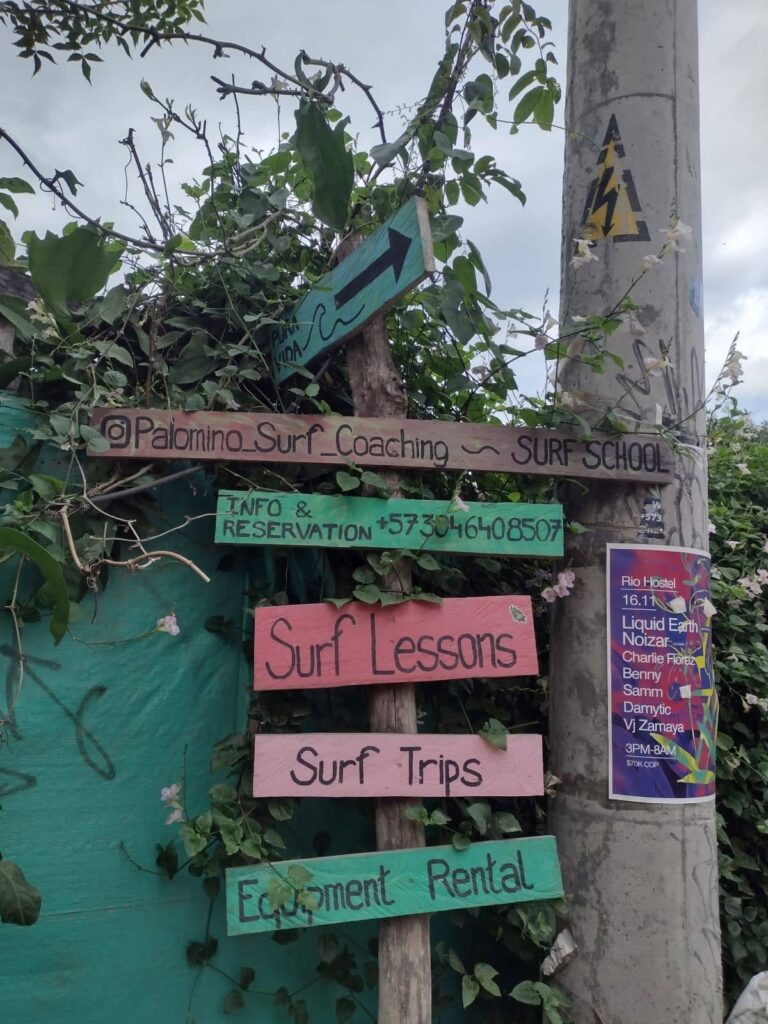
EVENINGS AT THE BEACH
The beach fills up with people and really comes to life as the sun starts making its inevitable descent. Some come to find a private spot for one of the best sunsets in Colombia, while others gather at the beach bars to start their night of fun.
Along with the early mornings, this was one of my favorite times. Energetic music brings a zestful atmosphere to the place, while the silhouettes of the endless palm trees add to the spectacle of a radiant, technicolor sky.
Behind them, the outline of the mountains makes for another wonderful sight. When the sun finally goes down, you can head back to town for dinner or join a group that’s planning to enjoy the starry night for a little longer.
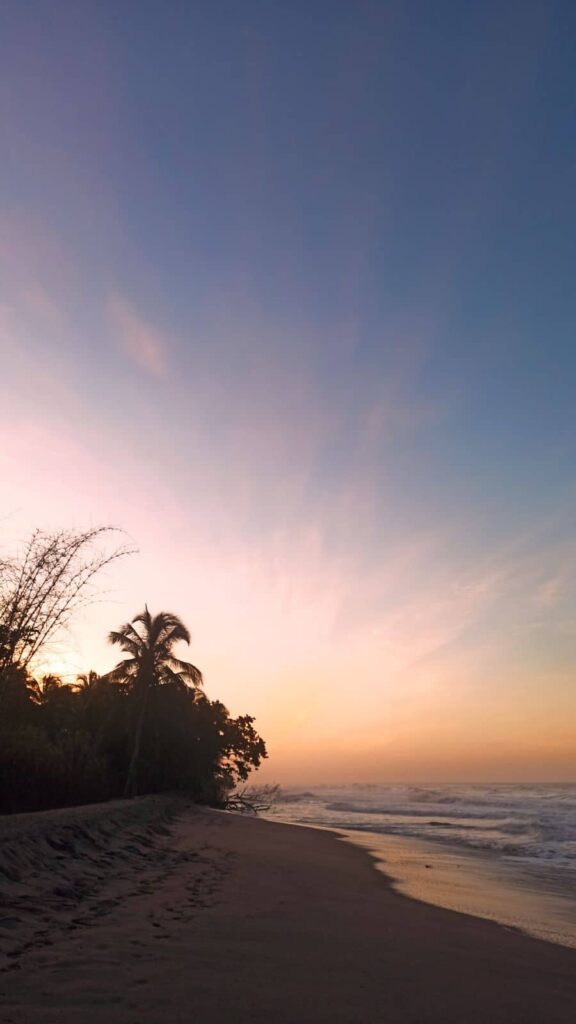
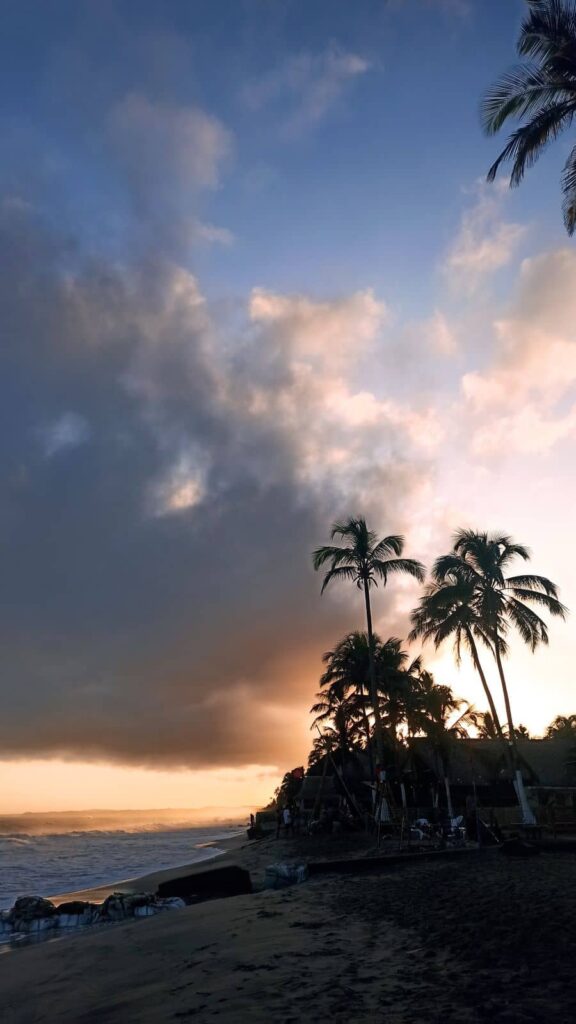
Try Some Amazing Food
For an isolated beach town like Palomino, I was surprised by the sheer number of great restaurants. This was one of the last places I visited on my travels through South America, so I decided to splurge a bit and eat out for almost every meal.
Palomino has a bit of everything, from traditional Colombian meals to backpacker fare (i.e. burgers and fries), plus a nice mix of Mediterranean options like falafel and thin-crust Italian pizza. And, if you’re vegetarian or vegan there’s an impressive amount of options for the likes of you.
Most places are either on Carrera 6 or within a few blocks and are reasonably priced, especially compared to the more popular coastal towns of Cartagena and Santa Marta.
Here are some of my favorite spots for a bite:
Maria Mulata | A hostel, bar, and restaurant all mixed in one. The atmosphere is lively, the staff friendly, and they do excellent burgers and have a great lunch deal. Their veggie bowl was also extremely good.

Restaurante Pizzeria y Bar La Frontera | They do a nice pizza with a thin crust and fresh ingredients. And, as far as I know, are the only place in town that does a vegan pizza.
Palomino Plaza | Not a single restaurant, but a small courtyard that has multiple street-food-style eateries. It’s right next to the beach and is a great place for those traveling in groups who all want something a bit different.
Grosso Empanadas Argentinas | This was maybe my favorite bite to eat in the whole town. They have a larger store and a small stand, both on Carrera 6. You’ll find people gathering at the stand in the afternoon waiting for the cheap and downright delicious empanadas. The BBQ pork and mushroom and cheese ones were especially tasty. Don’t forget to try their sauces too, especially the chimichurri.
Barba Beach Arabic Food | If you want a great shawarma this is the spot to go. They also have nice mixed plates, creamy hummus, and crisp falafel. If you’re vegan or vegetarian there are plenty of choices.
Sierra Bonita Restaurante | A small food shack, with a simple, delicious menu of “tropical food.” The fresh juices are wonderful and the ladies working there are friendly.
Veggie Kitchen | An open-air restaurant with nice juices, excellent smoothies, and a variety of delectable Buddha bowls.
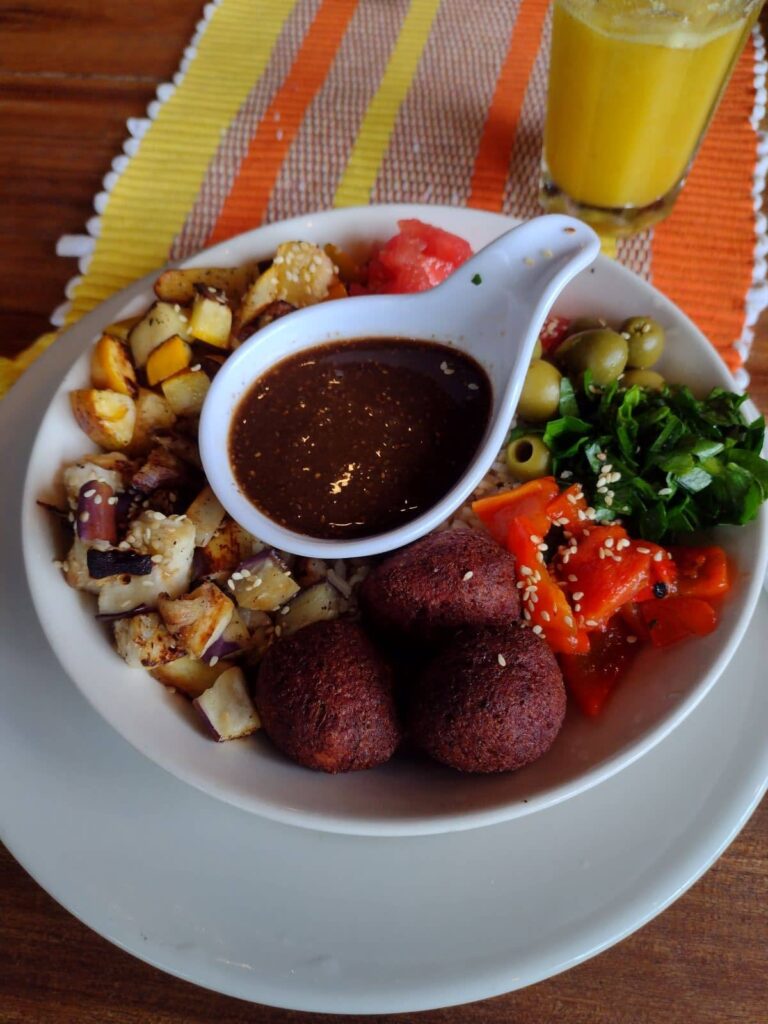
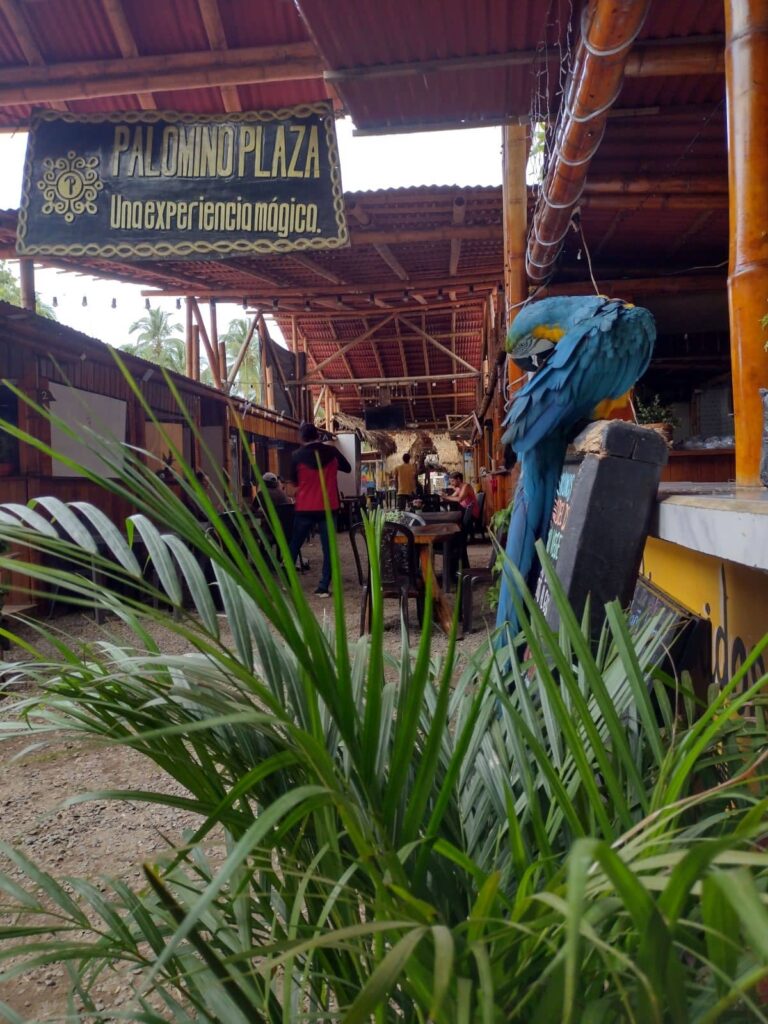
Shop The Streets
Palomino is a rugged-feeling beach town down to its very core, with dirt roads running from the main highway down to the wild coastline. I really enjoyed wandering the streets here, popping my head into small handicraft shops, and stopping by bohemian-styled clothing shops.
While there are still plenty of repetitive souvenir stores, I found them to be few and far between compared to other Colombian coastal towns. The atmosphere has more of a weekend market feel, with boutiques full of handwoven bracelets, crafted necklaces, and local art.
Between these shops, you’ll find the odd tattoo parlor, stores with handmade beauty products and the occasional artistic mural painted on the side of a building.
Most of the shopping is done on Carrera 6, with a few places appearing on the sidestreets that run perpendicular to it. This is where I found a unique, colorful bracelet (something I collect in each new country I visit), my partner found a hand-drawn postcard (something she collects in each new country), and our travel buddy got a small tattoo (something he does in every country).

Bakery Hopping In Palomino
There wasn’t a day I spent in Palomino without visiting one of the local bakeries. I guess there was something about early mornings at the beach that made me want a quick grab-and-go breakfast.
Add in Colombia’s coffee culture and you have a great pairing of freshly baked treats with a strong americano. I frequented a few places in particular and can’t recommend them enough.
My go-to place was La Sierrita Comedor (maps), a small cafe on a side street that specializes in vegan and vegetarian bites. The empanadas and cinnamon rolls stood out, although I didn’t have anything bad here.
For French-style pastries and decent quiches, La Panaderia Francesa (maps) is another superb option. The prices for some items are steep, but the quality is excellent and they have some nice breads.
Pan’omino Merenderia Cafeteria (maps) is hard to miss as you’re walking to the beach, and while not everything blew me away, the prices are more than fair and they have a large variety of pastries and desserts.
If you’re looking for a full breakfast Delicias Koda (maps) is another nice spot. They do combo deals, have great coffee, and the chocolate items are tasty. They do a lovely focaccia bread as well, for those that want something more savory.
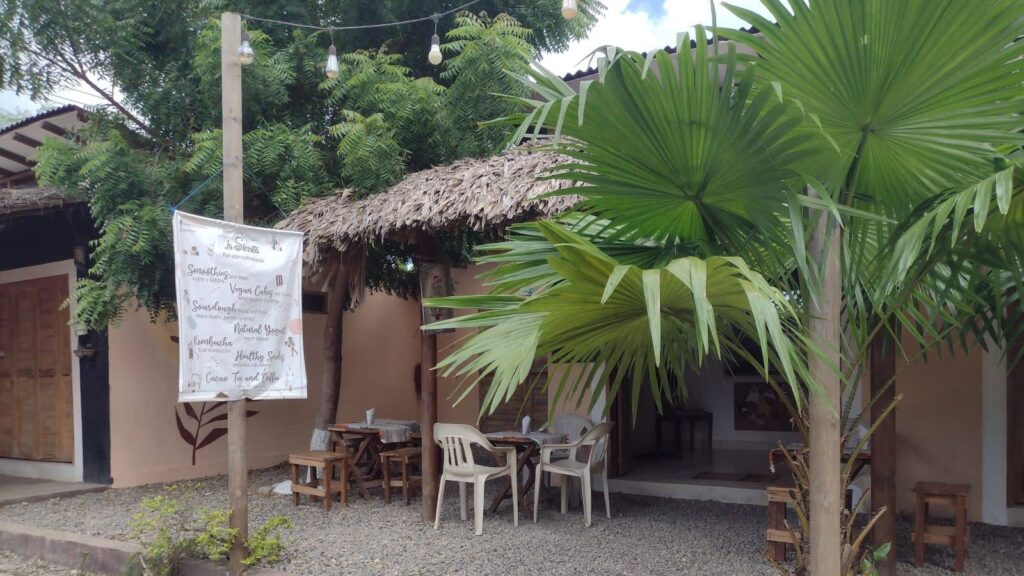
Embrace The Nightlife
Like most backpacker towns, Palomino has a thriving nightlife, with just about everything starting or ending at Playa Palomino.
It’s not uncommon for a bonfire or two to sprout up along the coast and last until sunrise, usually accompanied by dancing and music. Most beach bars come to life around sunset, the same goes for places along Carrera 6.
If you’re looking for a place to meet people, I suggest wandering the main street until you see somewhere that catches your eye. Besides that, there are more than a few hostels with bars connected that throw weekly events.
On each of my two visits to Palomino, there were also concerts going on in the area. One was a beach event with a DJ and salsa and the other was a jungle party a short drive away.
As with the majority of Colombia’s nightlife (and most places in general), remember to be aware of your surroundings when you’re out for the evening.
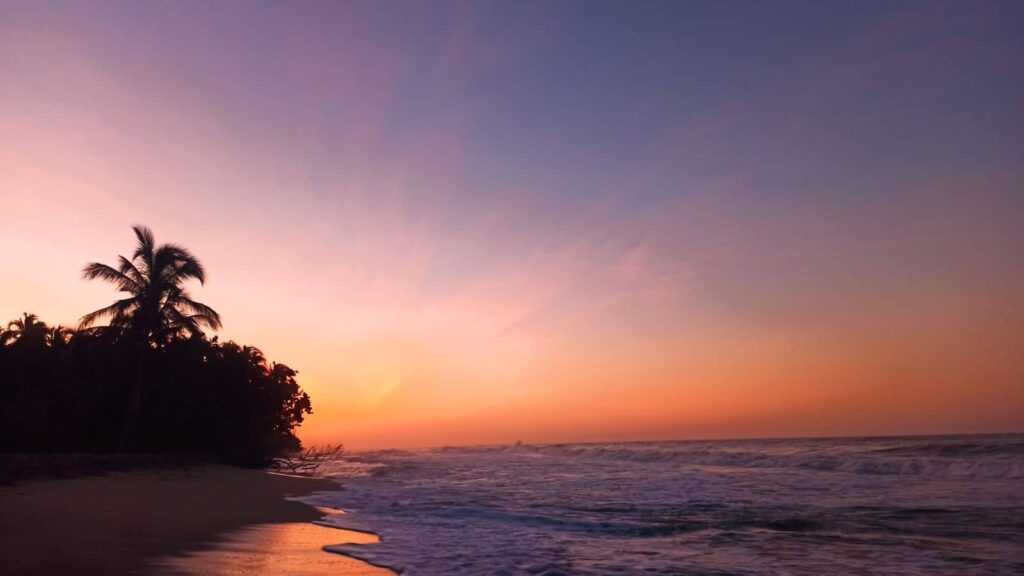
River Tubing
If you have a few days in the laid-back beach town, a lazy tube float on the Rio Palomino should be on your agenda. It’s one of the most popular activities to do, with several shacks around town offering tube rentals for those looking to relax for a few hours.
You’ll usually pay around 40,000 COP for the experience, which includes a motorbike trip to a drop-off point near the river. Once there, you’ll have a short 20-minute hike to an access point where the adventure begins.
The float should take you around 2 hours, so I suggest bringing some sunscreen and water for the journey. I also find that grabbing a few drinks at the grocery store beforehand never hurts on these types of trips. When you’re done, someone will collect your tube and you’ll have a 30 or so-minute walk back to town (or a short motorbike taxi ride).
It’s worth noting that when the water levels are low in the river, tubing is slow-going at its best and nearly impossible at its worst.
As an alternative to Rio Palomino, you can rent the same inflatable black tubes in towns like Buritaca or Rio Don Diego and spend the day drifting down their respective waterways. While it’s easy enough to do it yourself, you can also go on an organized tour. They’re more expensive but some like this one include a cultural exchange with a native village.
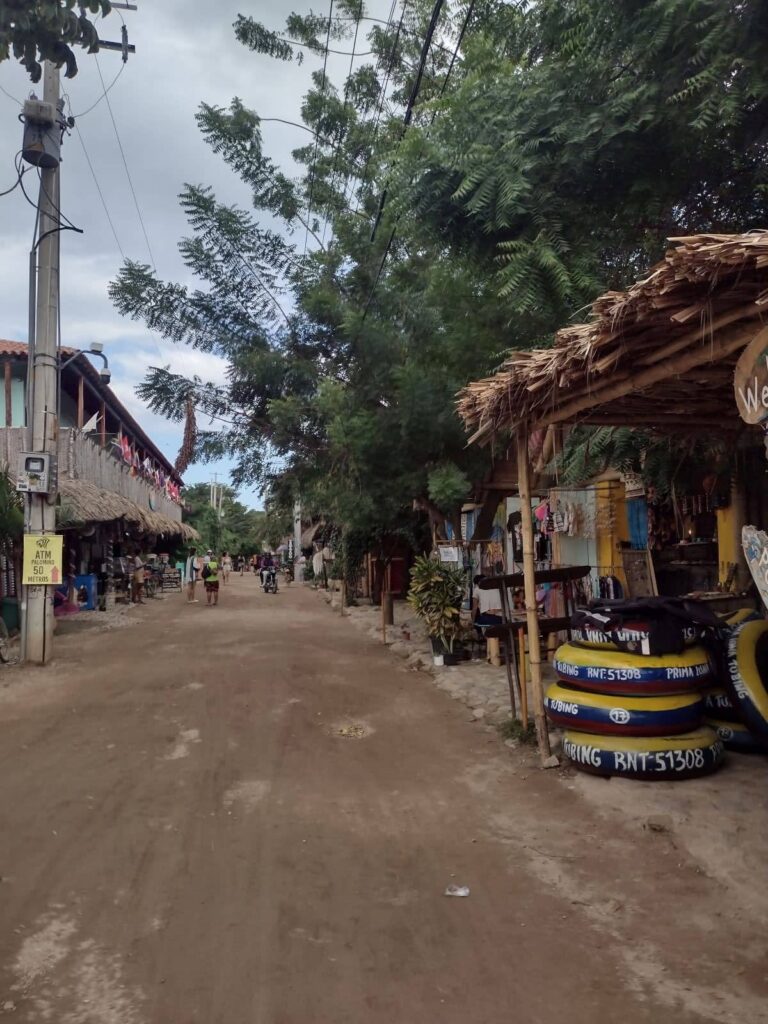
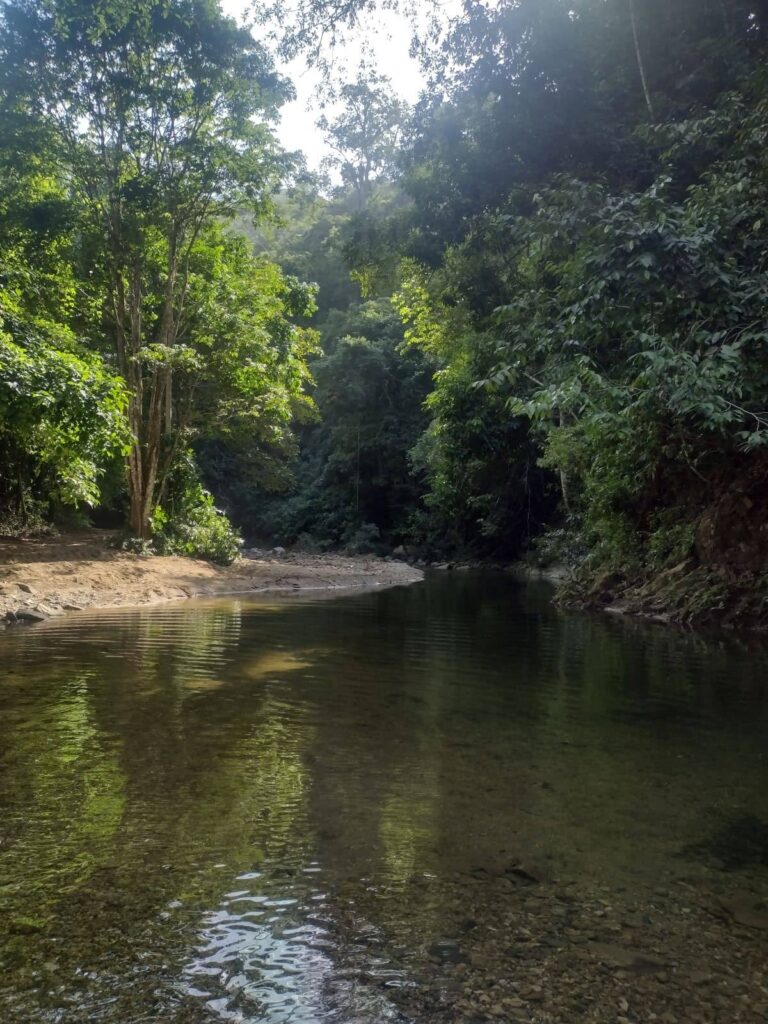
Explore The Surrounding Towns
For how out of the way it feels, Palomino is actually a great base for short-day trips. Some wonderful off-the-beaten-track villages are close by, with many popping up around the sprawl of rivers originating from the inland mountains.
Here are some places worth visiting as either day trips or the next step on your Colombia journey:
Buritaca | The small town is just to the west of Palomino and has a gorgeous wild beach. Renting river tubes and floating down the Rio Buritaca until you reach the white sand beach is pretty common.
Valencia | The main thing to do in Valencia is a short, amazing hike to the Valencia Waterfall. I’ll cover it in the next section, but, in my opinion, it’s a must-do if you’re in Palomino for more than a couple of nights.
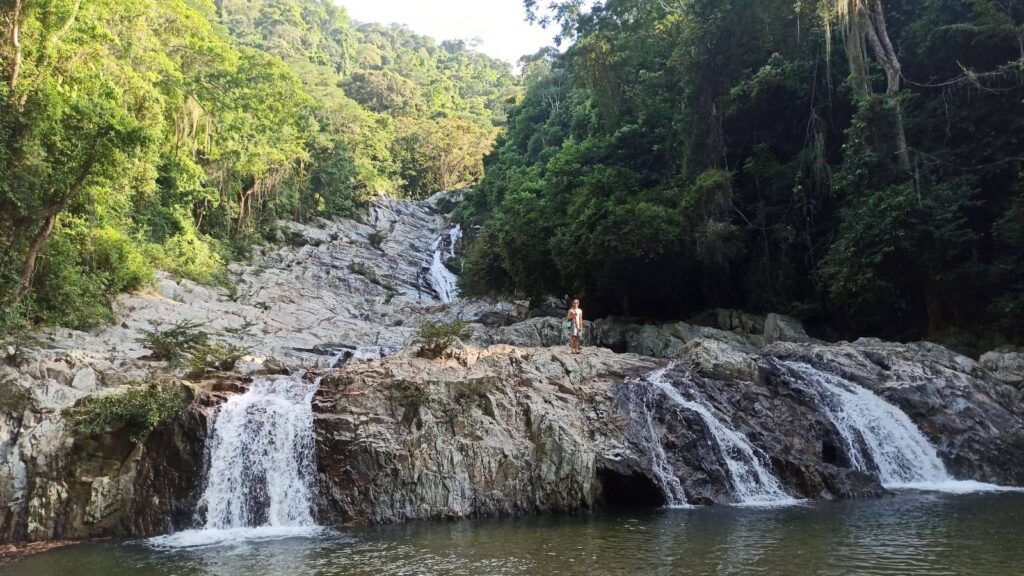
Mingueo | There really isn’t much to do here, but I have to mention it because it’s the closest place to Palomino with an actual ATM. If you’re staying long-term and don’t want to backtrack towards Santa Marta, you’ll have to grab a shared taxi/car if you want to take cash out.
Don Diego | Another small nearby town along a river (Rio Don Diego). Hiking and tubing are, once again, the main reason to visit.
Riohacha | A larger city to the east of Palomino known for its beaches and access to Colombia’s arid northeastern peninsula. Multi-day trips to Cabo de La Vela and Punta Gallinas often leave from here, as do day trips to Mayapo Beach.
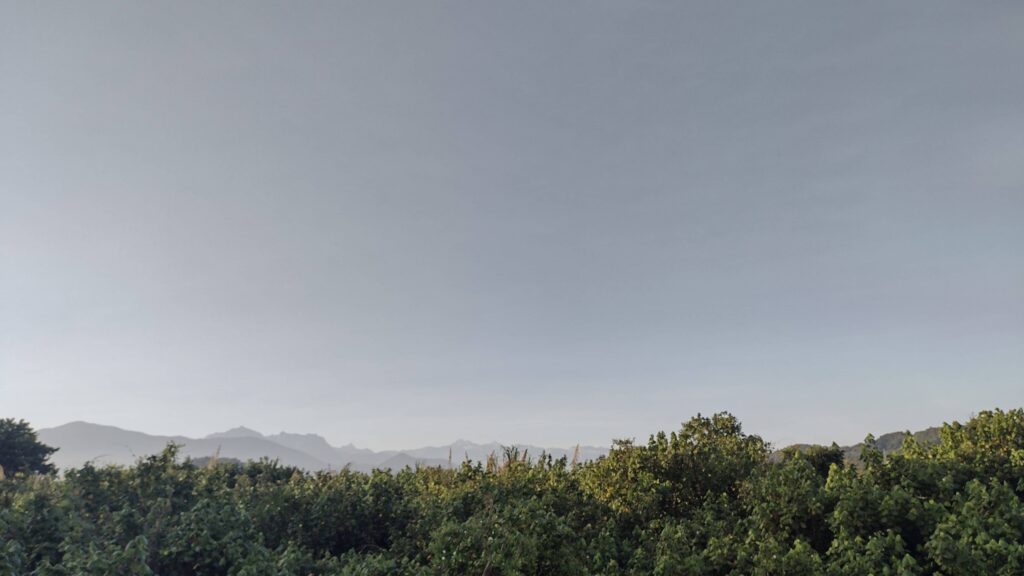
Valencia Waterfall Walk
After arriving at my accommodation, the guesthouse manager where I stayed had one recommendation; a trip to the Valencia Waterfall. I’m glad I took his advice as this was one of the most underrated things I did in Colombia.
The waterfall itself is gorgeous, with several cascades running down a gradually sloping rock face. At its base, you’ll find a refreshing natural swimming pool that eventually gives way to a shallow river.
To reach Quebrada Valencia or the Valencia Ravine as it’s known, you’ll have a short half-hour hike through the forest and, at times, across the winding ankle-deep waterway. At the beginning of the hike, you’ll also come across the massive Arbol Frondoso (Leafy Tree).
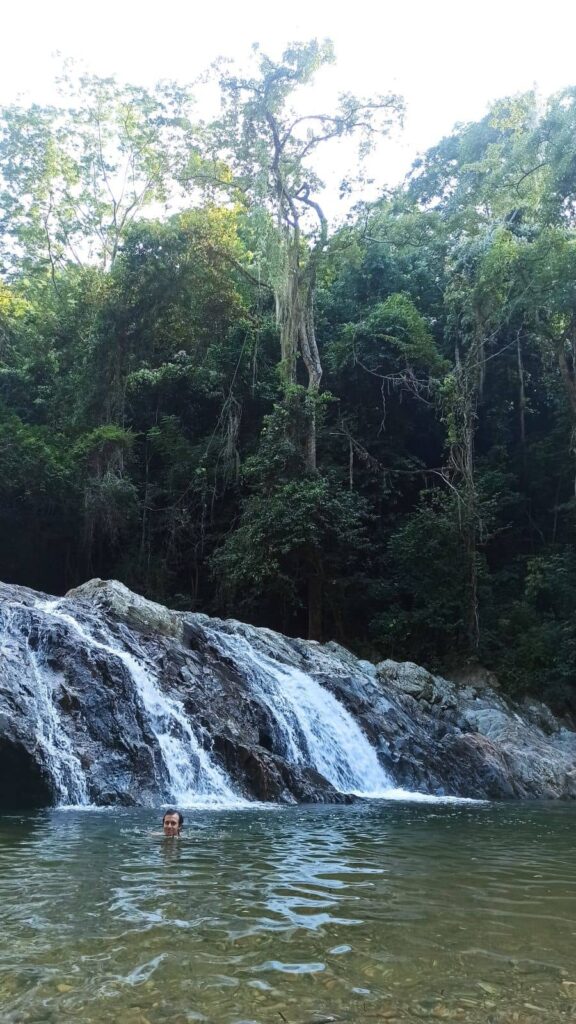
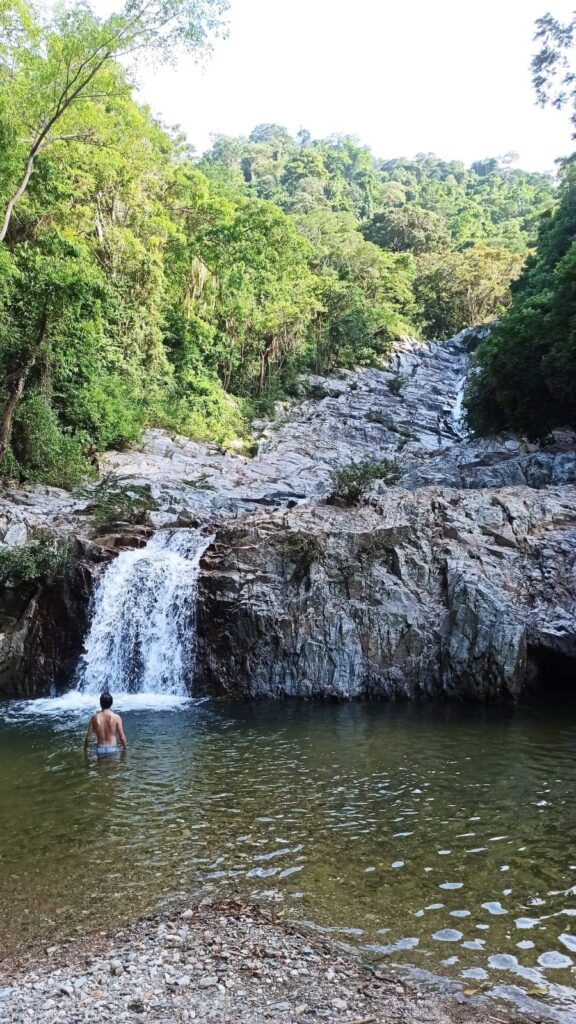
When you reach the final destination, there’s a wide gravel patch where people sunbathe and use it as a sort of rocky beach. If you’re feeling adventurous, you can climb up the varying levels of the falls to get a bird’s eye view of the natural landscape.
Getting There | To get to the waterfall (maps) by public transport, you take the Tayrona bus that heads between Palomino and Santa Marta. The trip is about 30 minutes each way. Let the bus employee know you’re heading here and you’ll be dropped off across the street from the trailhead.
Entrance Fee | Access to the trail leading to Valencia Waterfall costs 11,000 COP. There’s a small stand with a worker who collects the money and hands you a paper ticket. This doesn’t include the small fee for the public bus
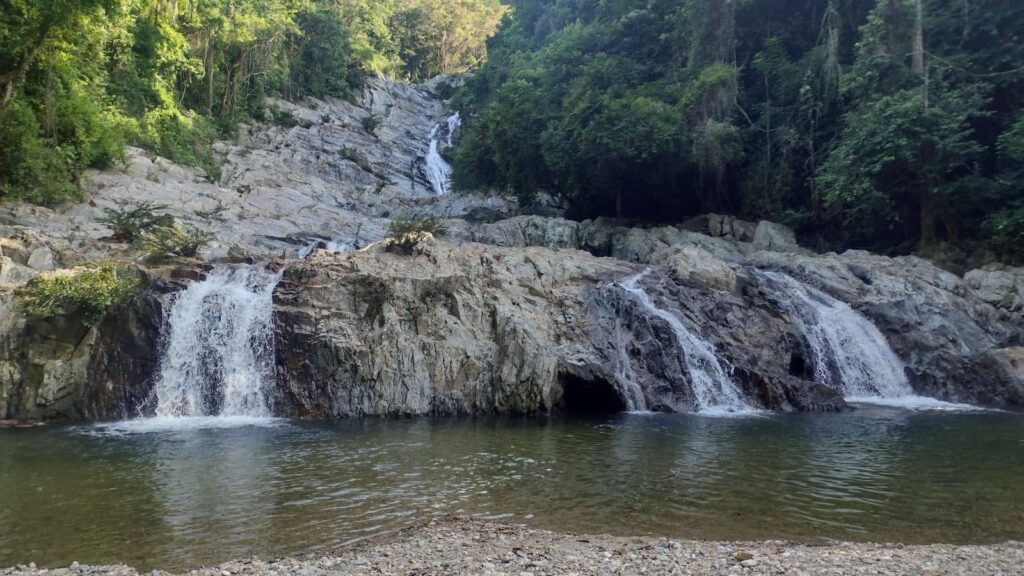
Visit Tayrona National Park
Tayrona National Park is a dreamlike place and an essential stop on most people’s northern Colombia itinerary. With miles of dense jungle that creeps up to the very edge of the sea, its beauty can’t be overstated.
Having said that more and more visitors rush to its rugged beaches every year, making it a “visit as soon as you can” destination. It also means that planning a trip in advance is a wise move. During the high season, even the hammocks at campsites can fill up fast.
If you’re wondering whether Palomino is a good starting point for adventuring through Tayrona National Park, I can safely say it is! This is where I was staying when I visited the park, and I was happy with my choice.
My accommodation was content holding my larger backpack as I spent a few nights camping on the beaches, and I’ve heard most others are the same. The relaxing vibes and fantastic restaurants also make it a great recovery spot when you’ve finished your trip. Plus, the bus to the park is less likely to overfill from the Palomino direction.

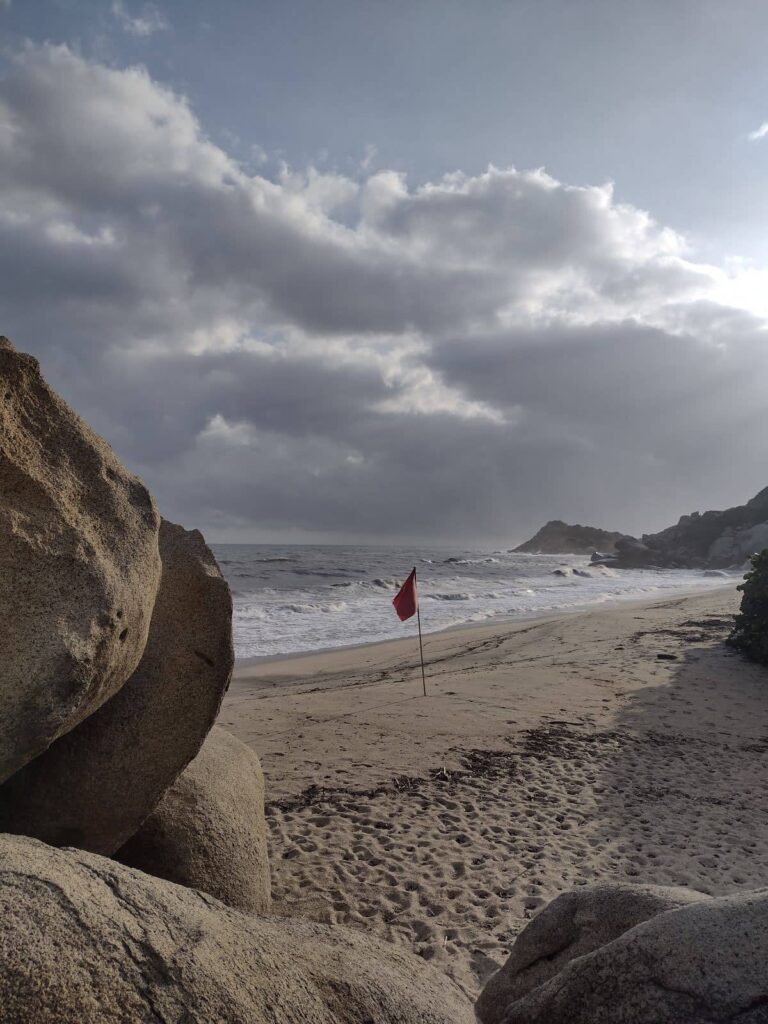
A BASIC OVERVIEW OF TAYRONA NATIONAL PARK
The Best Beaches To Visit | Canaveral Beach, Playa Nudista, Arrecifes Beach, Castillete Beach, Playa La Piscina, Playa Del Cabo, Playa Arenilla, and Playa Brava
Entrance Fee | 87,000 COP in high season and 73,000 COP in low season (as of 2024).
Where to enter coming from Palomino | El Zaino (the main entrance) or Calabazo (best for Playa Brava).
Campsites | Playa Brava, Playa Del Cabo, Arrecifes, and Castilletes.
Getting There | The Tayrona Bus leaves from the corner of Carrera 6 and the main highway.
Tips | Bring plenty of sunscreen and bug spray. Food and water are expensive, so it’s best to carry in as much of each as you can. Not all the beaches are swimmable, but it’s worth bringing snorkeling gear for the ones that are.
Visiting Tayrona National Park is a once-in-a-lifetime type of experience in Colombia’s little-touched wilderness. Remember that when you’re sweating profusely while trekking through the jungle or having a rough sleep in a not-so-clean-looking hammock!
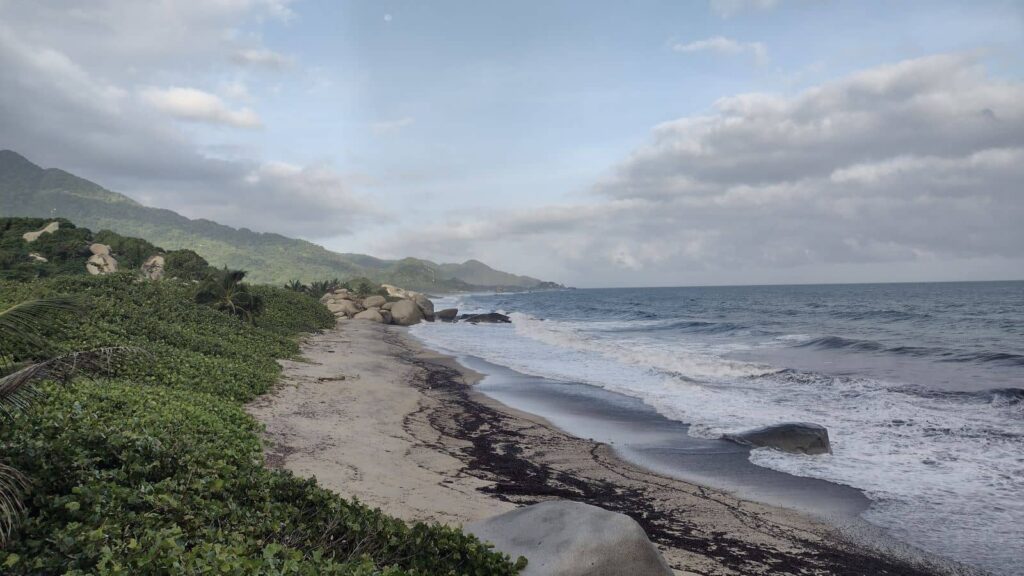
Take A Trip To Santa Marta
If you’ve made it to Palomino, there’s a high chance you stopped by Santa Marta along the way. After all, public transport to the eastern beaches of Colombia’s Caribbean coast begins from the historic city.
But, if you were adamant about avoiding the larger metropolis, you most likely just used it as a stopover. I can’t really fault anyone for this thinking, as I did the same thing on my first visit to the region.
That being said, Santa Marta still makes for an excellent day trip from Palomino. With its colorful colonial streets and unique museums, there’s just enough here to keep you busy for a full day. Plus, it’s easy to get to and from, with the direct bus heading there at regular intervals throughout the day.
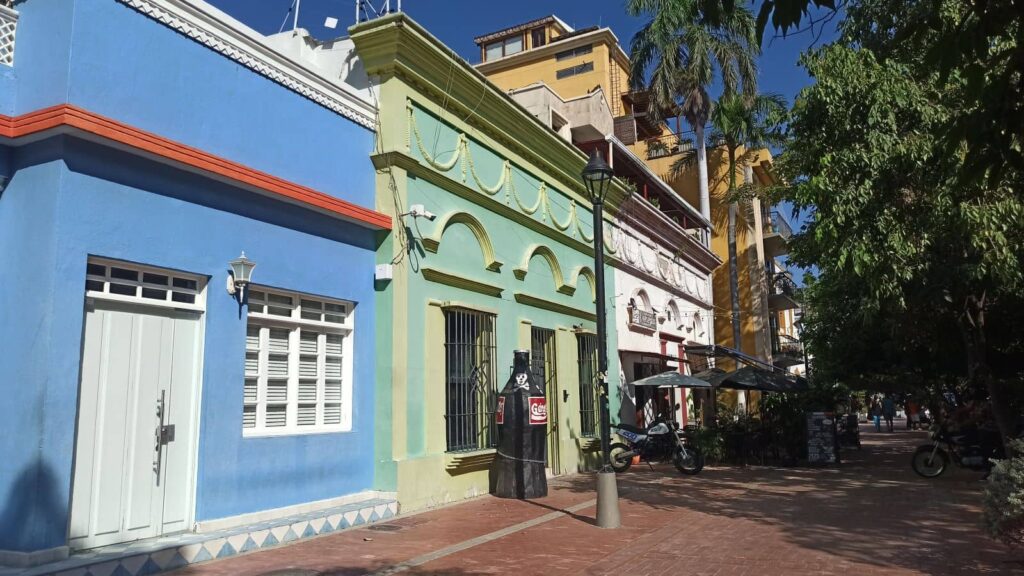
Here are some things worth doing when in Santa Marta:
- Walk the Malecon de Bastidas and catch the views of the calm bay. If you’re feeling up for it, you can hop on a boat and cruise the coastline.
- Afterward, head over to Plaza de Bolívar and stop by Casa de la Aduana. It houses the free-to-enter ‘Gold Museum’ and has artifacts from the Indigenous Tairona people.
- Wander the colonial old town, check out Parque de los Novios, and treat yourself to a tasty meal at one of the restaurants on Calle 19.
- Learn a bit of history and embrace art at the Simon Bolívar Museum. The lavish former mansion was where ‘El Libertador’ spent his final days.
- If you have your own vehicle, you can look into exploring the waterfalls and nature in Minca; Santa Marta’s mountain retreat town.
If you want a more detailed look at things to do in Santa Marta, check out my ‘Wonderful Things to do in Santa Marta’ guide.
How To Get There | You’ll take the same Tayrona bus you most likely took to get to Palomino. It leaves from the corner of Carrera 6 and the main highway and costs 13,000 COP each way. The journey takes around 2 hours, so it’s worth leaving early to have enough time to explore.
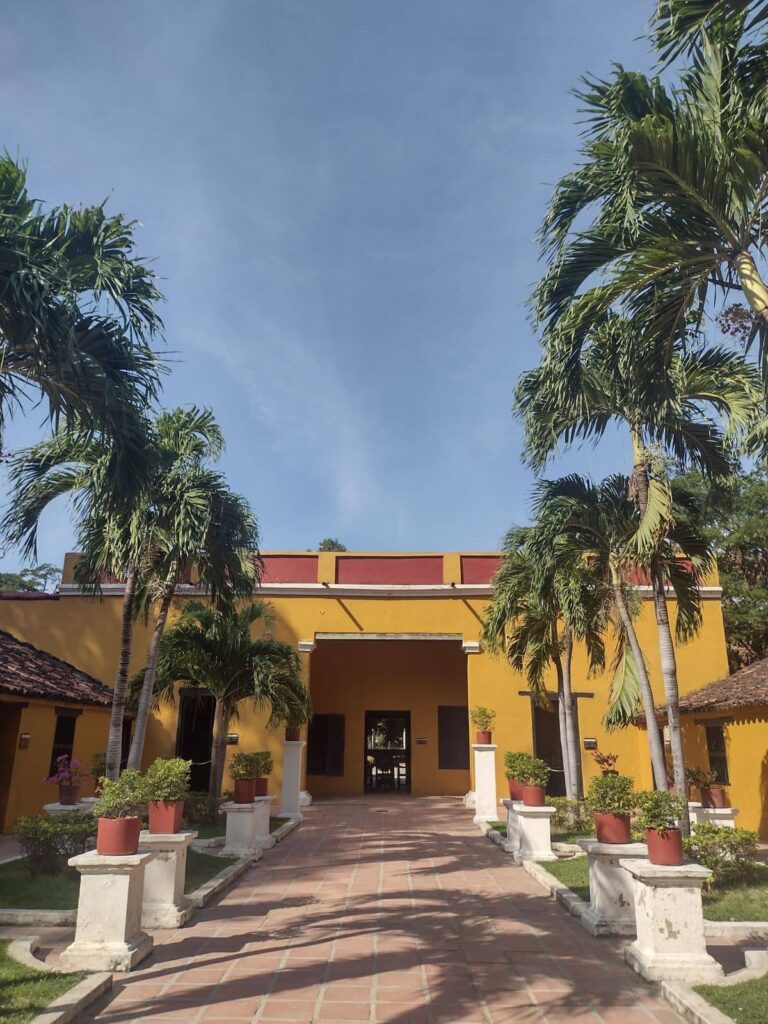
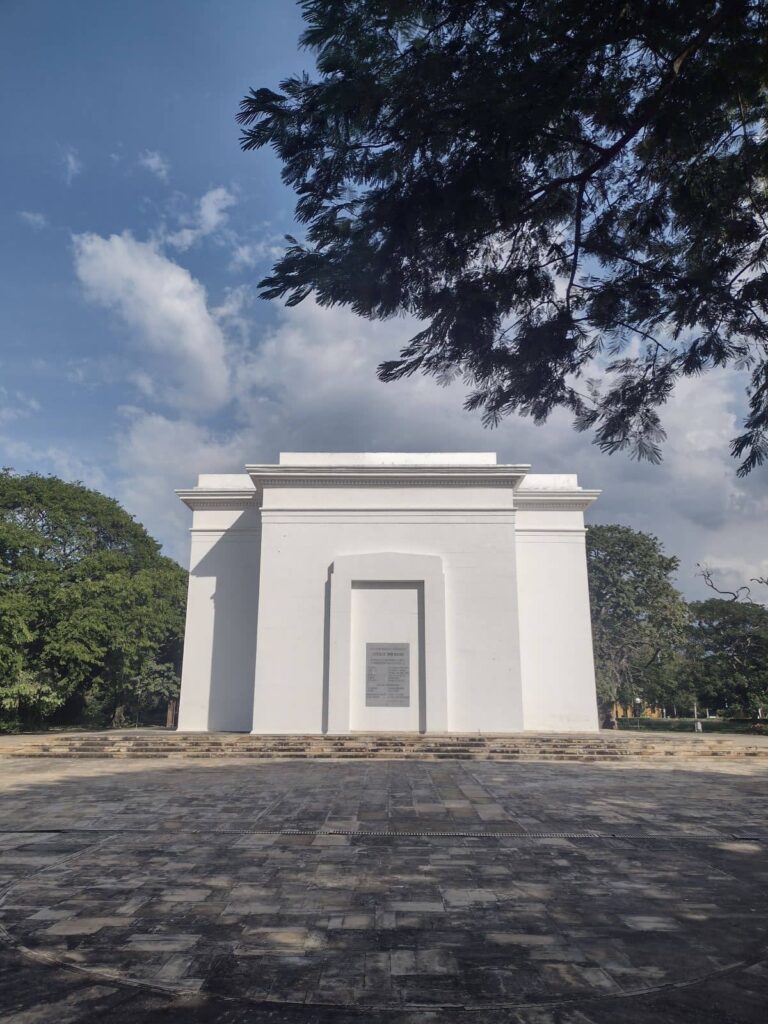
GETTING AROUND PALOMINO
As a smaller town built around dirt roads, it’s fair to say walking will be your main form of transport in Palomino. Everything is in close proximity, besides some of the day trip destinations I mentioned.
Everything in the direction of Santa Marta is reachable by the Tayrona bus that leaves from the corner of Carrera 6 and the main highway in Palomino. For Rihacha, you can head across the street and wave down larger buses heading in that direction. If that doesn’t seem to work, you can always backtrack to Santa Marta and head on a bus from there.
If you’re looking to head to Mingueo for the ATM, you can wave down a shared taxi/car that has a sign for Mingueo listed on it. I can’t remember the exact amount I paid, but it was under 8,000 COP. After asking around they told me to wait across the street from where the Palomino to Santa Marta buses leave.
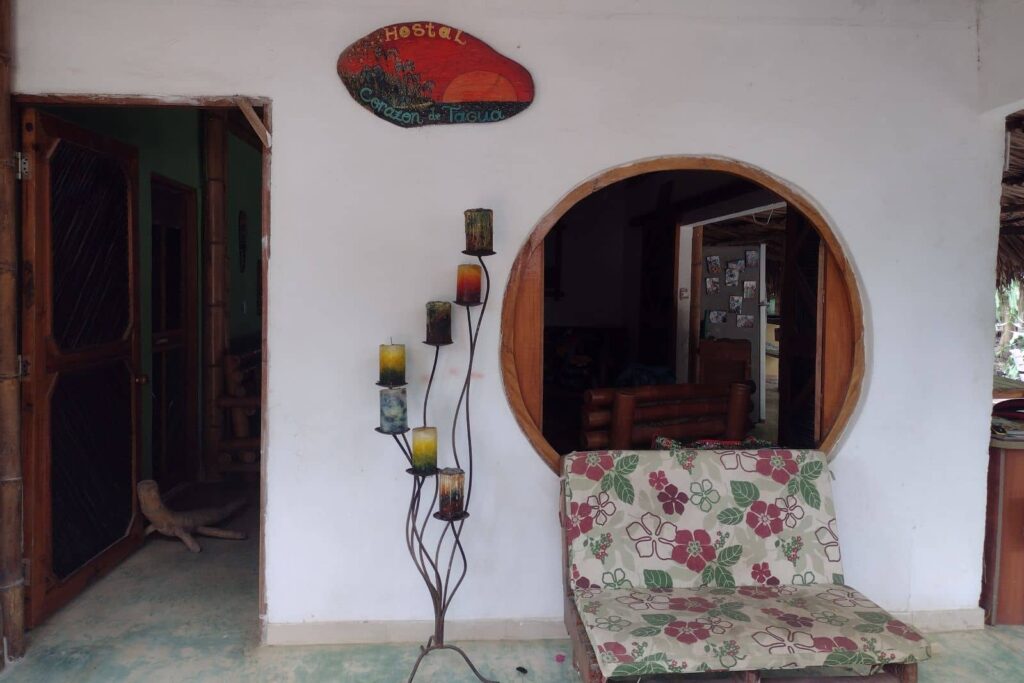
WHERE TO STAY IN PALOMINO
- Hostal Corazón de Tagua | A budget-friendly hostel with helpful staff and a laid-back atmosphere. My partner and I stayed in a private room and our friend in one of the dorms on two separate occasions. I’d go back again in a heartbeat.
- Tiki Hut Hostel & Palomino Sunrise | Two excellent accommodations that have courtyard pools surrounded by thatched roof bungalows. Both have private rooms and dorms at reasonable prices.
- Casa del Pavo Real Boutique Hotel | A wonderful mid-range boutique hotel that feels lavish. There are clean, modern rooms and a nice pool.
- Aite Eco Resort | A luxury option on the eastern part of the beach. It’s a bit away from the main part of town which makes it a quiet stay. The property is downright gorgeous, with palm trees lining its beach and a beautiful circular pool.
Check here for more options.









